1992 HONDA PRELUDE tow
[x] Cancel search: towPage 116 of 225

The Braking System
If this happens, you will immediate-
ly notice that the brake pedal goes
down much farther and you need to press on it much harder. A much
longer distance will be needed to stop the car.
Slow the car by downshifting to a
lower gear and removing your foot
from the accelerator pedal. Pull to
the side of the road as soon as it is
safe. Because of the longer stop-
ping distance needed, brake system
failure is very hazardous. It is best
to have your car towed, but if you
must drive the car in this condition,
be extremely cautious. Have your car repaired as soon as possible.
Anti-lock Brakes
The Prelude Si and Si 4WS models
in
the U.S. and SR and SR 4WS
models in Canada have an Anti-
lock Brake System (ABS) as standard equipment.
ABS helps you maintain steering
control. It does this by helping you
to prevent the wheels from locking
up and skidding.
The ABS is always "On". It
requires no special effort or driving
technique. You will feel a pulsation
in the brake pedal when the ABS
activates.
Activation varies with the amount of traction your tires have. On drypavement, you will need to press on
the brake pedal very hard before
you feel the pedal
pulsation that
means the ABS has activated.
However, you may feel the ABS
activate immediately if you are
trying to stop on snow or ice. Under all conditions, the ABS is helping to
prevent the wheels from locking so
you can retain steering
control.
You should continue to press on the
brake pedal with the same force.
You may feel a slight movement of
the brake pedal just after you start
the engine. This
is
the ABS
working.
Driving
CONTINUEDProCarManuals.comMain Menu Table of Contents s t
Page 120 of 225
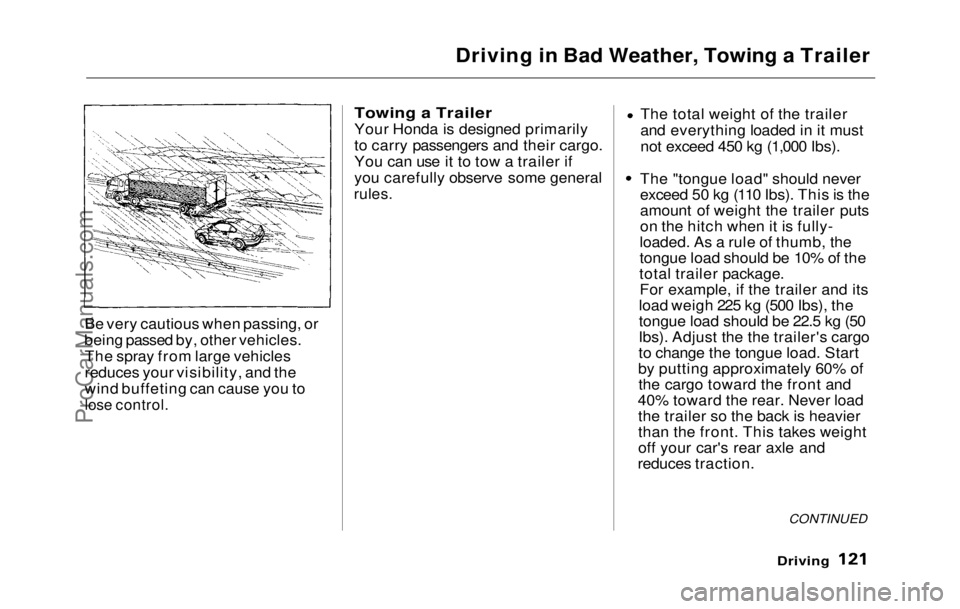
Driving in Bad Weather, Towing a Trailer
Be very cautious when passing, or
being passed by, other vehicles. The spray from large vehicles
reduces your visibility, and the
wind buffeting can cause you to
lose control.
Towing a Trailer
Your Honda is designed primarily
to carry passengers and their cargo.
You can use it to tow a trailer if
you carefully observe some general
rules.
The total weight of the trailer
and everything loaded in it must
not exceed 450 kg (1,000 Ibs). The "tongue load" should never
exceed 50 kg (110 Ibs). This is the
amount of weight the trailer puts
on the hitch when it is fully-
loaded. As a rule of thumb, the
tongue load should be 10% of the
total trailer package. For example, if the trailer and its
load weigh 225 kg (500 Ibs), the
tongue load should be 22.5 kg (50
Ibs). Adjust the the trailer's cargo
to change the tongue load. Start
by putting approximately 60% of the cargo toward the front and
40% toward the rear. Never load the trailer so the back is heavier
than the front. This takes weight
off your car's rear axle and
reduces traction.
CONTINUED
DrivingProCarManuals.comMain Menu Table of Contents s t
Page 121 of 225
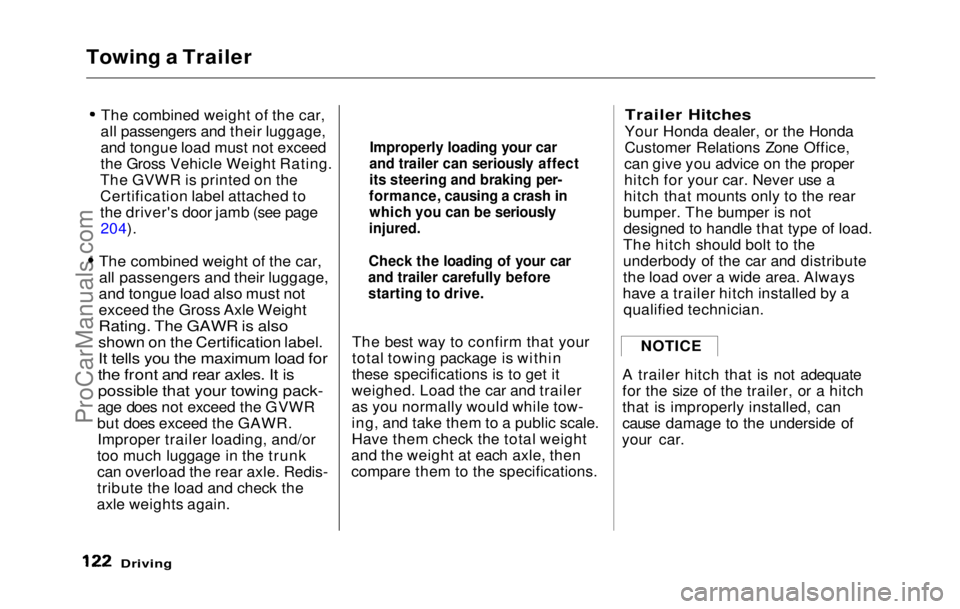
Towing a Trailer
The combined weight of the car,
all passengers and their luggage,
and tongue load must not exceed
the Gross Vehicle Weight Rating.
The GVWR is printed on the
Certification label attached to
the driver's door jamb (see page 204).
The combined weight of the car,
all passengers and their luggage,
and tongue load also must not
exceed the Gross Axle Weight
Rating. The GAWR is
also
shown on the Certification label.
It tell
s
you the maximum load for
the front and rear axles. It is
possible that your towing pack-
age does not exceed the GVWR
but does exceed the GAWR. Improper trailer loading, and/or
too much luggage in the trunk
can overload the rear axle. Redis-
tribute the load and check the
axle weights again. The best way to confirm that your
total towing package is within
these specifications is to get it
weighed. Load the car and trailer
as you normally would while tow-
ing, and take them to a public scale.
Have them check the total weight
and the weight at each axle, then
compare them to the specifications.
Trailer Hitches
Your Honda dealer, or the Honda
Customer Relations Zone Office,
can give you advice on the proper
hitch for your car. Never use a
hitch that mounts only to the rear
bumper. The bumper is not
designed to handle that type of load.
The hitch should bolt to the
underbody of the car and distribute
the load over a wide area. Always
have a trailer hitch installed by a qualified technician.
A trailer hitch that is not adequate
for the size of the trailer, or a hitch
that is improperly installed, can
cause damage to the underside of
your car.
Driving
Improperly loading your car
and trailer can seriously affect
its steering and braking per-
formance, causing a crash in which you can be seriously
injured.
Check the loading of your car
and trailer carefully before
starting to drive.
NOTICEProCarManuals.comMain Menu Table of Contents s t
Page 122 of 225
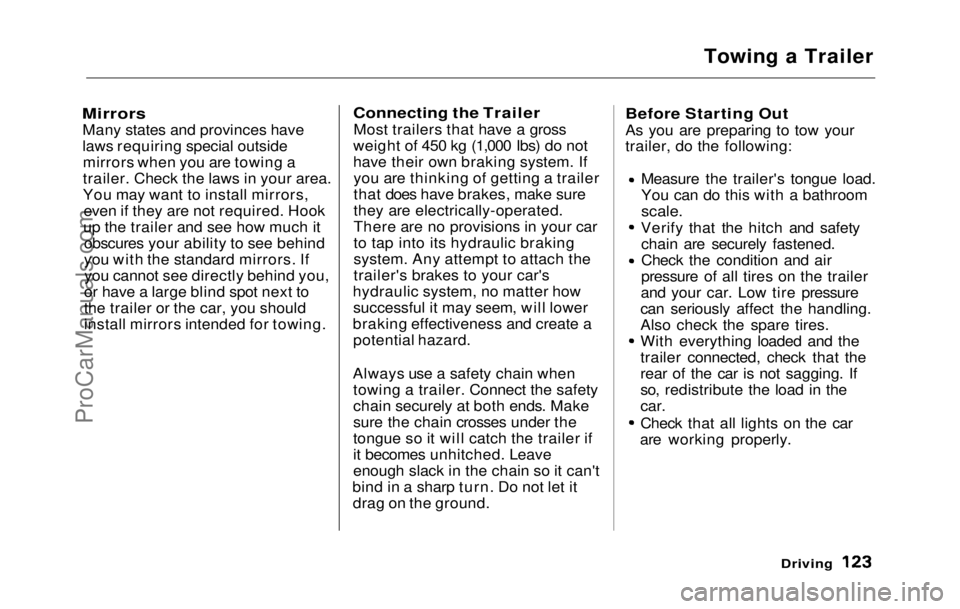
Towing a Trailer
Mirrors
Many states and provinces have
laws requiring special outsidemirrors when you are towing a
trailer. Check the laws in your area.
You may want to install mirrors, even if they are not required. Hook
up the trailer and see how much it obscures your ability to see behind
you with the standard mirrors. Ifyou cannot see directly behind you,
or have a large blind spot next to
the trailer or the car, you should
install mirrors intended for towing.
Connecting the Trailer
Most trailers that have a gross
weight of 450 kg (1,000 Ibs) do not
have their own braking system. If you are thinking of getting a trailer
that does have brakes, make sure
they are electrically-operated.
There are no provisions in your car
to tap into its hydraulic braking
system. Any attempt to attach the
trailer's brakes to your car's
hydraulic system, no matter how successful it may seem, will lower
braking effectiveness and create a potential hazard.
Always use a safety chain when towing a trailer. Connect the safety
chain securely at both ends. Make
sure the chain crosses under the
tongue so it will catch the trailer if
it becomes unhitched. Leave
enough slack in the chain so it can't
bind in a sharp turn. Do not let it drag on the ground.
Before Starting Out
As you are preparing to tow your
trailer, do the following:
Measure the trailer's tongue load.
You can do this with a bathroom
scale.
Verify that the hitch and safety chain are securely fastened.
Check the condition and air
pressure of all tires on the trailer
and your car. Low tire pressure
can seriously affect the handling.
Also check the spare tires.
With everything loaded and the
trailer connected, check that the
rear of the car is not sagging. If
so, redistribute the load in the
car.
Check that all lights on the car
are working properly.
DrivingProCarManuals.comMain Menu Table of Contents s t
Page 123 of 225
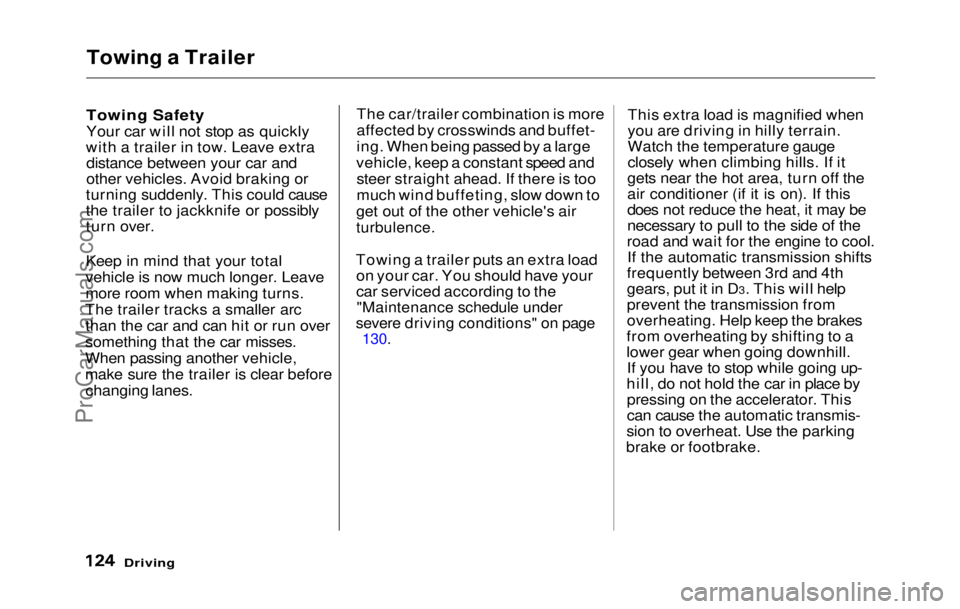
Towing a Trailer
Towing Safety
Your car will not stop as quickly
with a trailer in tow. Leave extra distance between your car and
other vehicles. Avoid braking or
turning suddenly. This could cause
the trailer to jackknife or possibly
turn over.
Keep in mind that your total
vehicle is now much longer. Leave
more room when making turns.
The trailer tracks a smaller arc than the car and can hit or run over
something that the car misses.
When passing another vehicle,
make sure the trailer is clear before changing lanes. The car/trailer combination is more
affected by crosswinds and buffet-
ing. When being passed by a large
vehicle, keep a constant speed and steer straight ahead. If there is too
much wind buffeting, slow down to
get out of the other vehicle's air
turbulence.
Towing a trailer puts an extra load on your car. You should have your
car serviced according to the
"Maintenance schedule under
severe driving conditions" on page
130.
This extra load is magnified when
you are driving in hilly terrain.
Watch the temperature gauge
closely when climbing hills. If it
gets near the hot area, turn off the
air conditioner (if it is on). If this
does not reduce the heat, it may be
necessary to pull to the side of the
road and wait for the engine to cool. If the automatic transmission shifts
frequently between 3rd and 4th
gears, put it in D3. This will help
prevent the transmission from
overheating. Help keep the brakes
from overheating by shifting to a
lower gear when going downhill. If you have to stop while going up-
hill, do not hold the car in place by pressing on the accelerator. This
can cause the automatic transmis-
sion to overheat. Use the parking
brake or footbrake.
DrivingProCarManuals.comMain Menu Table of Contents s t
Page 124 of 225

Towing a Trailer
Driving
When parking your car and trailer,
especially on a hill, be sure to
follow all the normal precautions.
Turn your front wheels into the curb, set the parking brake firmly,
and put the transmission in 1st or
Reverse (5-speed) or Park (auto-
matic). In addition, place wheel chocks at each of the trailer's tires.
Backing up with a trailer is diffi-
cult and takes practice. Drive
slowly, make small movements
with the steering wheel, and havesomeone stand outside to guide you.
Grip th e
steering wheel on the
bottom (rather than the usual posi- tion near the top). Move your hand
to the left to get the trailer to move
to the left, and right to move the
trailer right.ProCarManuals.comMain Menu Table of Contents s t
Page 127 of 225

Maintenance Schedule
R — Replace I — Inspect After inspection, clean, adjust, repair or replace if necessary.
Severe Driving Conditions Items with an or in the chart will need service
more often, if you drive in some servere conditions.
The conditions are:
A. Repeated short distance driving.B. Dusty conditions.
C. Severe cold weather.
D. Areas with road salt or other corrosive materials.
E. Rough or muddy roads.
F. Towing a trailer.
The services are:
— Clean the air cleaner element every 24,000 km (15,000 miles) or 12 months and replace every 48,000 km (30,000 miles) or 24 months under condition B or E.
— Replace engine oil and oil filter every 6,000 km (3,750 miles) o r 3 months under condition A,
B or F
.
— Replace transmission oil every 24,000 km (15,000 miles) or 12 months under condition F.
— Inspect front brake discs and calipers, and rear brake discs, calipers and pads every 12,000 km (7,500 miles) or 6 months under condition A, B, D, E or F.
— Inspect the power steering system every 12,000 km (7,500 miles) o
r 6 months under
condition B, C or E.
Maintenance
ProCarManuals.comMain Menu Table of Contents s t
Page 133 of 225
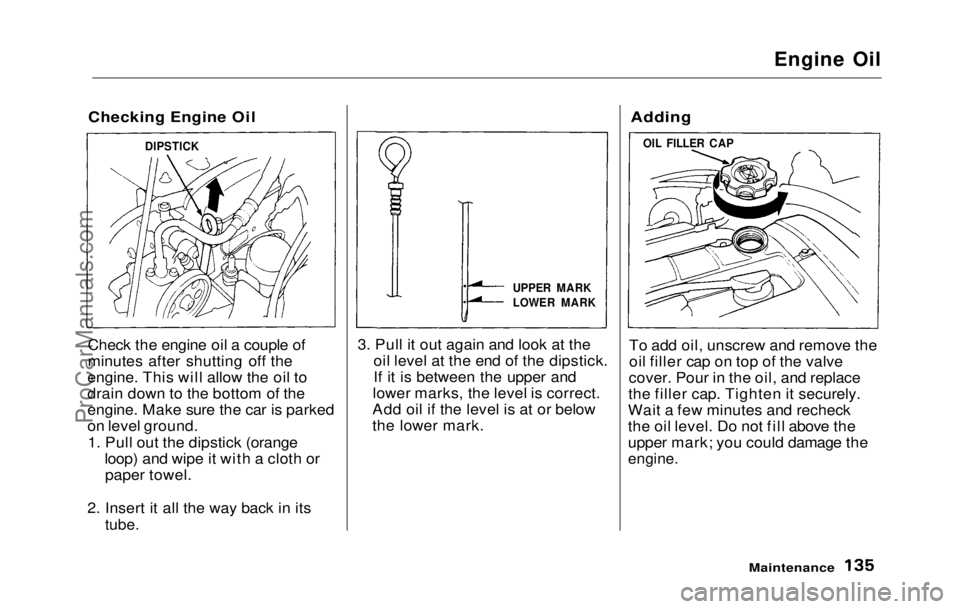
Engine Oil
Checking Engine Oil
Check the engine oil a couple of
minutes after shutting off the
engine. This will allow the oil to
drain down to the bottom of the
engine. Make sure the car is parked
on level ground.
1. Pull out the dipstick (orange
loop) and wipe it with a cloth orpaper towel.
2. Insert
it all the way back in its
tube.
3. Pull
it out again and look at the
oil level at the end of the dipstick.
If it is between the upper and
lower marks, the level is correct.
Add oil if the level is at or below
the lower mark.
Adding
To add oil, unscrew and remove the
oil filler cap on top of the valve
cover. Pour in the oil, and replace
the filler cap. Tighten it securely.
Wait a few minutes and recheck
the oil level. Do not fill above the
upper mark; you could damage the
engine.
Maintenance
UPPER MARK
LOWER MARK
OIL FILLER CAP
DIPSTICKProCarManuals.comMain Menu Table of Contents s t